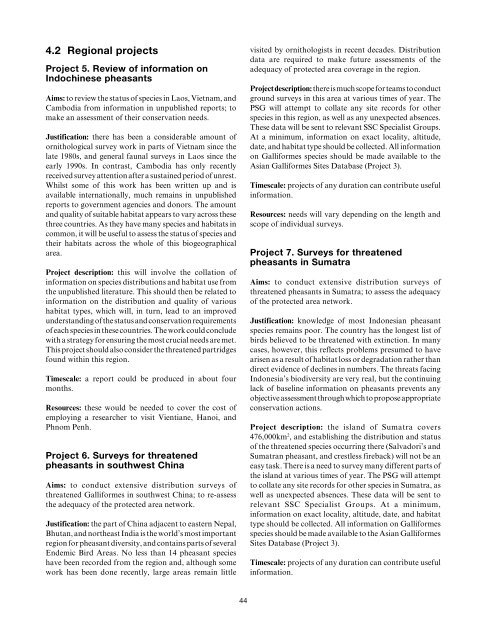Pheasants: Status Survey and Conservation Action Plan ... - IUCN
Pheasants: Status Survey and Conservation Action Plan ... - IUCN
Pheasants: Status Survey and Conservation Action Plan ... - IUCN
Create successful ePaper yourself
Turn your PDF publications into a flip-book with our unique Google optimized e-Paper software.
4.2 Regional projects<br />
Project 5. Review of information on<br />
Indochinese pheasants<br />
Aims: to review the status of species in Laos, Vietnam, <strong>and</strong><br />
Cambodia from information in unpublished reports; to<br />
make an assessment of their conservation needs.<br />
Justification: there has been a considerable amount of<br />
ornithological survey work in parts of Vietnam since the<br />
late 1980s, <strong>and</strong> general faunal surveys in Laos since the<br />
early 1990s. In contrast, Cambodia has only recently<br />
received survey attention after a sustained period of unrest.<br />
Whilst some of this work has been written up <strong>and</strong> is<br />
available internationally, much remains in unpublished<br />
reports to government agencies <strong>and</strong> donors. The amount<br />
<strong>and</strong> quality of suitable habitat appears to vary across these<br />
three countries. As they have many species <strong>and</strong> habitats in<br />
common, it will be useful to assess the status of species <strong>and</strong><br />
their habitats across the whole of this biogeographical<br />
area.<br />
Project description: this will involve the collation of<br />
information on species distributions <strong>and</strong> habitat use from<br />
the unpublished literature. This should then be related to<br />
information on the distribution <strong>and</strong> quality of various<br />
habitat types, which will, in turn, lead to an improved<br />
underst<strong>and</strong>ing of the status <strong>and</strong> conservation requirements<br />
of each species in these countries. The work could conclude<br />
with a strategy for ensuring the most crucial needs are met.<br />
This project should also consider the threatened partridges<br />
found within this region.<br />
Timescale: a report could be produced in about four<br />
months.<br />
Resources: these would be needed to cover the cost of<br />
employing a researcher to visit Vientiane, Hanoi, <strong>and</strong><br />
Phnom Penh.<br />
Project 6. <strong>Survey</strong>s for threatened<br />
pheasants in southwest China<br />
Aims: to conduct extensive distribution surveys of<br />
threatened Galliformes in southwest China; to re-assess<br />
the adequacy of the protected area network.<br />
Justification: the part of China adjacent to eastern Nepal,<br />
Bhutan, <strong>and</strong> northeast India is the world’s most important<br />
region for pheasant diversity, <strong>and</strong> contains parts of several<br />
Endemic Bird Areas. No less than 14 pheasant species<br />
have been recorded from the region <strong>and</strong>, although some<br />
work has been done recently, large areas remain little<br />
visited by ornithologists in recent decades. Distribution<br />
data are required to make future assessments of the<br />
adequacy of protected area coverage in the region.<br />
Project description: there is much scope for teams to conduct<br />
ground surveys in this area at various times of year. The<br />
PSG will attempt to collate any site records for other<br />
species in this region, as well as any unexpected absences.<br />
These data will be sent to relevant SSC Specialist Groups.<br />
At a minimum, information on exact locality, altitude,<br />
date, <strong>and</strong> habitat type should be collected. All information<br />
on Galliformes species should be made available to the<br />
Asian Galliformes Sites Database (Project 3).<br />
Timescale: projects of any duration can contribute useful<br />
information.<br />
Resources: needs will vary depending on the length <strong>and</strong><br />
scope of individual surveys.<br />
Project 7. <strong>Survey</strong>s for threatened<br />
pheasants in Sumatra<br />
Aims: to conduct extensive distribution surveys of<br />
threatened pheasants in Sumatra; to assess the adequacy<br />
of the protected area network.<br />
Justification: knowledge of most Indonesian pheasant<br />
species remains poor. The country has the longest list of<br />
birds believed to be threatened with extinction. In many<br />
cases, however, this reflects problems presumed to have<br />
arisen as a result of habitat loss or degradation rather than<br />
direct evidence of declines in numbers. The threats facing<br />
Indonesia’s biodiversity are very real, but the continuing<br />
lack of baseline information on pheasants prevents any<br />
objective assessment through which to propose appropriate<br />
conservation actions.<br />
Project description: the isl<strong>and</strong> of Sumatra covers<br />
476,000km 2 , <strong>and</strong> establishing the distribution <strong>and</strong> status<br />
of the threatened species occurring there (Salvadori’s <strong>and</strong><br />
Sumatran pheasant, <strong>and</strong> crestless fireback) will not be an<br />
easy task. There is a need to survey many different parts of<br />
the isl<strong>and</strong> at various times of year. The PSG will attempt<br />
to collate any site records for other species in Sumatra, as<br />
well as unexpected absences. These data will be sent to<br />
relevant SSC Specialist Groups. At a minimum,<br />
information on exact locality, altitude, date, <strong>and</strong> habitat<br />
type should be collected. All information on Galliformes<br />
species should be made available to the Asian Galliformes<br />
Sites Database (Project 3).<br />
Timescale: projects of any duration can contribute useful<br />
information.<br />
44
















